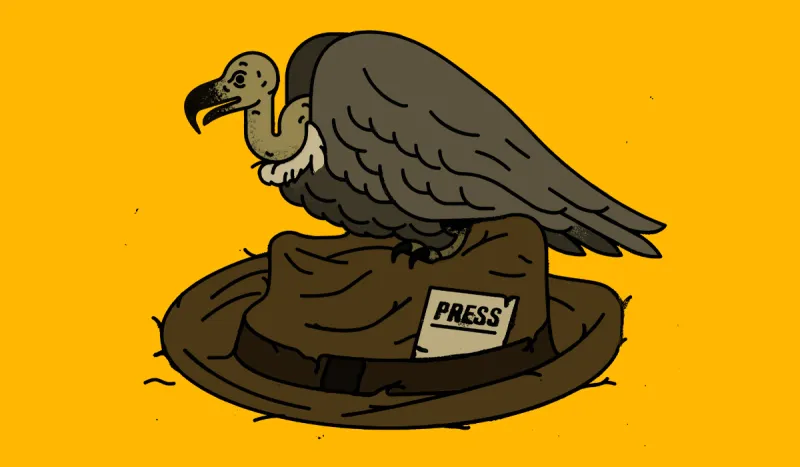
Illustration by Yarek Waszul.
Hedge funds don’t make good owners of newspapers — at least if reporters at those newspapers are to be believed.
Since 2010 hedge funds and private equity firms have been targeting legacy media companies. The investors acquire newspapers at low prices, then cut costs in the hope of selling at better multiples. But the state of the news business hasn’t improved, leading some firms to continue making cuts, leaving fewer and fewer reporters in place.
“It’s been hell, to say the least,” says one reporter for Southern California News Group by phone. “I’m kind of at a loss for words, except for it’s completely fucked.”
The source spoke on background and asked to remain anonymous because of concerns that the owner of the reporter’s paper could retaliate.
According to the source, when hedge fund Alden Global Capital created Southern California News Group in 2016, there were a few layoffs that seemed to be for “human resources” reasons. The deal combined the Los Angeles News Group — which was already owned by Digital First Media, the newspaper arm of Alden — with Freedom Communications.
Then, in September 2017, came the first wave of major staff cuts. Staffers were offered voluntary buyouts, under which they would receive 16 weeks of severance.
At the time, staffers were told that these would be the last layoffs for at least three years. The newsrooms began to rearrange themselves, but efforts were stymied, arousing suspicion on the part of the staff that the September layoffs wouldn’t be the last.
Their suspicions turned out to be correct. At the end of December 2017, Digital First announced that more layoffs were coming. First the sports and features teams were hit, according to the source. Then in February, it was the main newsrooms. Copy desks and design teams were next, in March.
“A lot of typos are finding their way into the papers,” the source notes.
According to the reporter, executive editors estimate that across Digital First’s properties, the staff has been cut in half. The explanation from the top is that Alden needed to realign profits.
“We’re owned by a hedge fund that doesn’t care about good journalism,” says the source. “They want to maintain a certain profit margin. They don’t care about finding new revenue streams, but cutting costs.”
As for the future at the paper?
“It looks pretty bleak, to tell you the truth,” the reporter says. “We’re not going to get raises. We’re not going to get more people. As long as Alden continues to own us, there will be more layoffs and fewer and fewer people and fewer ways to advance within the company.”
Newspapers hold a special place in U.S. history. They were written into the Constitution via the First Amendment, and have played an important role since then in ensuring that politicians and corporations are truthful.
“For 100 years newspapers were a great business, and then they weren’t,” says Jim Casella, a longtime industry veteran and onetime chairman and CEO of business media company Asset International.
Hedge funds and private equity firms have a history of investing in newspapers and media companies that dates back to the 1980s, when they began taking small stakes in publicly traded companies like Gannett, Knight Ridder, and The New York Times, according to Penelope Muse Abernathy, a Philip H. Knight chair and journalism professor at the University of North Carolina.
In the early 2000s the popularity of newspapers grew among institutional investors, which started taking larger positions in the publicly traded companies.
Abernathy notes that hedge funds and private equity firms plan to exit their investments roughly three to five years after making them. In 2008, she says, the price of a newspaper company starting falling from 13x earnings. By 2011 newspapers could be bought out of bankruptcy for three times earnings, especially when an entire chain was being acquired. This made the industry attractive to hedge funds and private equity firms, which swooped in to make acquisitions.
The strategy is to acquire, cut costs, and quickly sell. The problem, though, is finding buyers after those three to five years. With no more costs to cut and little consideration for future revenue sources, these newspapers flounder and sometimes shut down.
“Most hedge funds and pension funds have focused primarily on cost-cutting, but not on long-term revenue strategies that retain current readers and advertisers and attract new ones,” Abernathy says by phone. “Such strategies often require significant up-front investment and may depress profitability in the short-term.”
What’s more, in some cases, particularly that of Alden, hedge funds have taken cost savings from the newspapers and plowed them back into their other investments, according to Abernathy.
To be sure, Southern California News Group isn’t the lone victim of cost-cutting strategies. The Denver Post is a particularly relevant example, with its staff revolting against its owner, Alden, on the editorial pages in recent weeks.
“Here in Colorado, Alden has embarked on a cynical strategy of constantly reducing the amount and quality of its offerings while steadily increasing its subscription rates,” staffers wrote in an April 6 editorial published in the paper and online. “In doing so, the hedge fund managers — often tellingly referred to as ‘vulture capitalists’ — have hidden behind a narrative that adequately staffed newsrooms and newspapers can no longer survive in the digital marketplace.”
Alden did not respond to a phone call and an email seeking comment. Digital First also did not respond to a phone call seeking comment.
“With the newspapers, there’s kind of two different classes of owners,” notes Casella. “You have some who are very wealthy, like Jeff Bezos, who can expand coverage and rebuild things. The other extreme you have are the groups that try to figure out where the bottom is and how cheaply they can buy it.”
Though Alden is among the most widely known cost-cutters, Fortress Investments’ New Media Investment Group is the largest newspaper owner, as of 2018, with 445 papers under management, according to data collected by Abernathy. By comparison, Alden’s Digital First owns the third-most papers, with 172 under management.
“It bothers me a lot that we get lumped in with Alden,” says Michael Reed, CEO of New Media, by phone. “We’re a public company, just like Gannett in terms of ownership. Our public shareholders are not hedge funds.” (According to Fortress’s website, New Media is a publicly traded “permanent capital vehicle.”)
II Deep Dive: Can Tribune Survive Without Gannett?
Reed’s background is in the media business. He’s been a chief executive officer of media companies for the past 20 years. Speaking on the phone about the business, Reed is earnest in his belief that newspapers can thrive in the future. To be sure, New Media hasn’t seen the scale of layoffs that Alden’s newspapers have.
And New Media’s total shareholder returns, according to Reed, have outpaced those of the S&P 500 over the past four years. As of April 17, New Media’s total returns were 74.7 percent, as compared with the S&P 500’s total returns of 60.4 percent.
However, its stock price over roughly the same time period has not.
Over the past five years, New Media’s stock price has increased roughly 11 percent, from $15.62 per share to $17.70 per share on April 18. Meanwhile, the S&P 500 has risen nearly 71 percent, from $158.24 per share to $270.39 per share, during the same time period.
“So much of the ad dollar goes to Facebook and Google and leaves everybody else to fight for what’s left,” Casella said.
So what’s to become of newspapers and digital media companies in the future? Is there a world in which hedge funds and private equity firms can invest in these companies rather than cutting their costs?
Hedge funds benefit from the cost-cutting strategy Alden employs, at least at first. But long-term, as Abernathy notes, the strategy doesn’t work. She suggests instead that hedge funds investing in community building and marketing resources could be a boon for these newspapers, and thus for the investments.
The solution is complex, according to Casella. He said he believes there is room, especially for smaller newspapers, to hang on.
“I think the small regional newspapers can survive,” Casella said. “There’s really not an alternative in the space for them. The markets aren’t big enough to create a digital product.”
But the source at Southern California News Group is skeptical that hedge funds and private equity firms will be the owners of these future small-town papers.
“As long as hedge funds gobble up resources, local journalism will struggle,” the reporter says.





